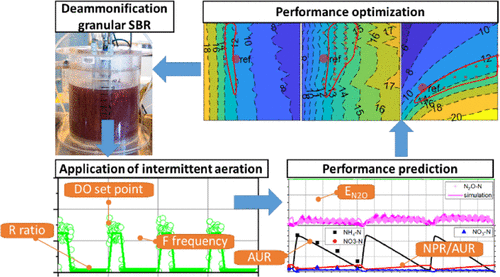当前位置:
X-MOL 学术
›
Environ. Sci. Technol.
›
论文详情
Our official English website, www.x-mol.net, welcomes your
feedback! (Note: you will need to create a separate account there.)
Optimization of the Aeration Strategies in a Deammonification Sequencing Batch Reactor for Efficient Nitrogen Removal and Mitigation of N2O Production
Environmental Science & Technology ( IF 10.8 ) Pub Date : 2020-12-30 , DOI: 10.1021/acs.est.0c04229 Hussein E. Al-Hazmi 1 , Xi Lu 1, 2 , Joanna Majtacz 1 , Przemyslaw Kowal 1 , Li Xie 2 , Jacek Makinia 1
Environmental Science & Technology ( IF 10.8 ) Pub Date : 2020-12-30 , DOI: 10.1021/acs.est.0c04229 Hussein E. Al-Hazmi 1 , Xi Lu 1, 2 , Joanna Majtacz 1 , Przemyslaw Kowal 1 , Li Xie 2 , Jacek Makinia 1
Affiliation

|
In deammonification systems, nitrite-oxidizing bacteria (NOB) suppression and nitrous oxide (N2O) mitigation are two important operational objectives. To carry out this multivariable analysis of response, a comprehensive model for the N cycle was developed and evaluated against experimental data from a laboratory-scale deammonification granular sludge sequencing batch reactor. Different aeration strategies were tested, and the manipulated variables comprised the dissolved oxygen (DO) set point in the aerated phase, aeration on/off frequency (F), and the ratio (R) between the non-aerated and aerated phase durations. Experimental results showed that a high ammonium utilization rate (AUR) in relation to the low nitrate production rate (NPR) (NPR/AUR = 0.07–0.08) and limited N2O emissions (EN2O < 2%) could be achieved at the DO set point = 0.7 mg O2/L, R ratio = 2, and F frequency = 6–7 h–1. Under specific operational conditions (biomass concentration, NH4+-N loading rate, and temperature), simulation results confirmed the feasible aeration strategies for the trade-offs between the NOB suppression and N2O emission. The intermittent aeration regimes led to frequent shifts in the predominating N2O production pathways, that is, hydroxylamine (NH2OH) oxidation (aerated phase) versus autotrophic denitrification (non-aerated phase). The inclusion of the extracellular polymeric substance mechanism in the model explained the observed activity of heterotrophs, especially Anaerolineae, and granule formation.
中文翻译:

脱氨测序间歇反应器曝气策略的优化,以有效去除氮并减少N 2 O的产生
在脱氨系统中,抑制亚硝酸盐氧化细菌(NOB)和减少一氧化二氮(N 2 O)是两个重要的操作目标。为了进行响应的这种多变量分析,开发了一个N循环的综合模型,并根据实验室规模的脱氨颗粒污泥测序批处理反应器的实验数据进行了评估。测试了不同的充气策略,操纵变量包括充气阶段的溶解氧(DO)设定点,充气开/关频率(F)以及非充气和充气阶段持续时间之间的比率(R)。实验结果表明,较高的铵利用率(AUR)与较低的硝酸盐生产率(NPR)(NPR / AUR = 0.07–0.08)和有限的N 2在DO设定点= 0.7 mg O 2 / L,R比= 2,F频率= 6–7 h –1时,可以实现O排放(E N 2 O <2%)。在特定的操作条件下(生物质浓度,NH 4 + -N加载速率和温度),模拟结果证实了可行的曝气策略,可以在NOB抑制和N 2 O排放之间进行权衡。间歇的曝气方式导致主要的N 2 O生产途径(即羟胺(NH 2OH)氧化(充气阶段)与自养反硝化(非充气阶段)。在模型中包括细胞外聚合物质机制,解释了观察到的异养生物,特别是厌氧细菌的活性和颗粒形成。
更新日期:2021-01-19
中文翻译:

脱氨测序间歇反应器曝气策略的优化,以有效去除氮并减少N 2 O的产生
在脱氨系统中,抑制亚硝酸盐氧化细菌(NOB)和减少一氧化二氮(N 2 O)是两个重要的操作目标。为了进行响应的这种多变量分析,开发了一个N循环的综合模型,并根据实验室规模的脱氨颗粒污泥测序批处理反应器的实验数据进行了评估。测试了不同的充气策略,操纵变量包括充气阶段的溶解氧(DO)设定点,充气开/关频率(F)以及非充气和充气阶段持续时间之间的比率(R)。实验结果表明,较高的铵利用率(AUR)与较低的硝酸盐生产率(NPR)(NPR / AUR = 0.07–0.08)和有限的N 2在DO设定点= 0.7 mg O 2 / L,R比= 2,F频率= 6–7 h –1时,可以实现O排放(E N 2 O <2%)。在特定的操作条件下(生物质浓度,NH 4 + -N加载速率和温度),模拟结果证实了可行的曝气策略,可以在NOB抑制和N 2 O排放之间进行权衡。间歇的曝气方式导致主要的N 2 O生产途径(即羟胺(NH 2OH)氧化(充气阶段)与自养反硝化(非充气阶段)。在模型中包括细胞外聚合物质机制,解释了观察到的异养生物,特别是厌氧细菌的活性和颗粒形成。











































 京公网安备 11010802027423号
京公网安备 11010802027423号